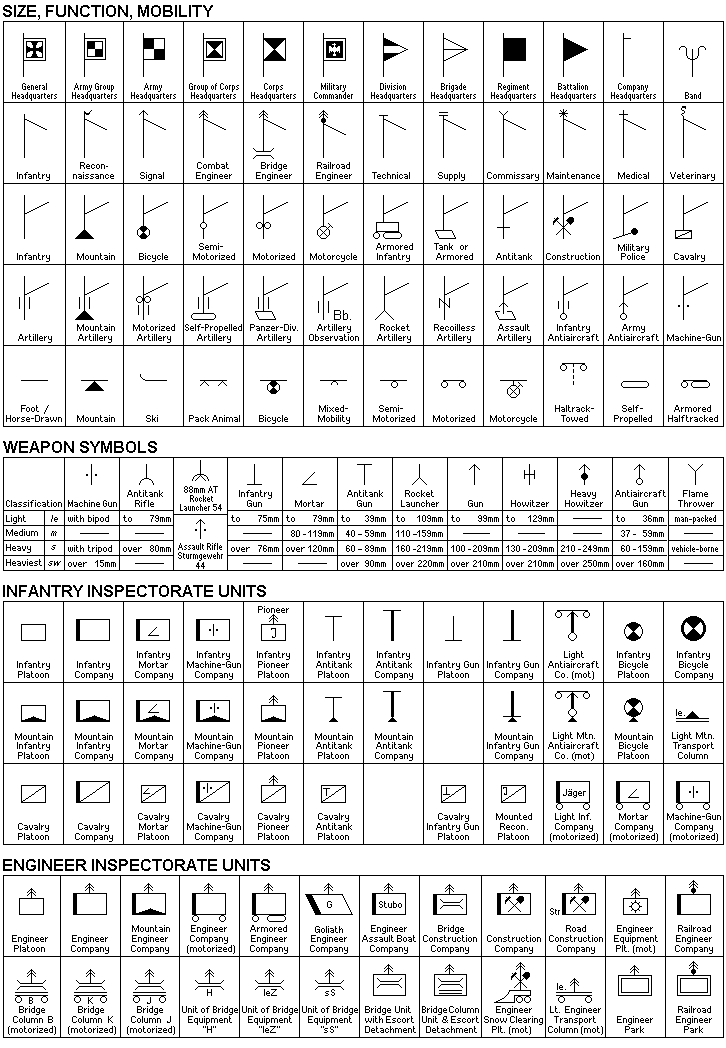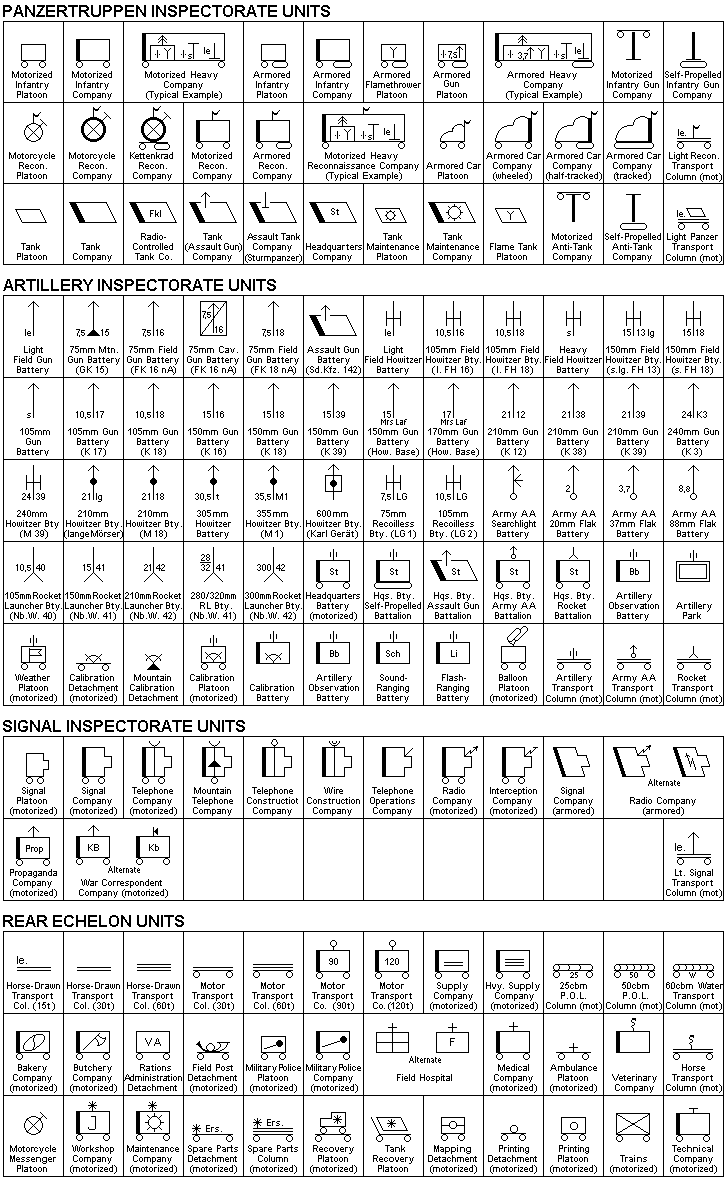| World War II Armed Forces — Orders of Battle and Organizations | Last Updated 04.02.2022 |


| Explanation of German Units and Organizational Symbols |
|
The symbols in this work are based on the official German handbook of military symbols (H.Dv. 272) of 23 May 1943, and the symbols of the organizational charts (Kriegsgliederung des Feldheeres – 1.07.1943) .
The 1943 organizational symbols were simplified. The anti-tank units now also used a representation of the basic anti-tank gun symbol itself. The weapons symbols themselves were no longer modified, but instead had information placed next to them. In German organizational charts (and, as reflected in this work), the headquarters symbol represents two purposes. First, it indicated the size, function, and mobility of the unit. And, second, it also indicated the headquarters of that echelon itself. I.e., there was no separate symbol for this echelon's headquarters. For all headquarters units with (and sometimes important units without) separate KStN, the corresponding symbols were placed to the right of the echelon's symbol. The same applied to those units that were directly assigned to the echelon's headquarters. The different functions and mobility additions were used to enhance the echelon's symbol to indicate a specific purpose. Company-sized units and sub-units symbols were also modified in a similar fashion. An interesting feature of company and sub-unit symbols is that their size and shape dimensions could be altered to fit the diagram being depicted with them. Several infantry companies, for example, were placed side-by-side, elongated upwards, (so that all weapons symbols could fit within), and only the left-hand company had the thickened edge used to indicate its size (more of this below). The variations in size and shape followed the original configuration, so that the basic symbol was still recognizable as such. The symbols were intended to be mnemonic. The headquarters symbols reflected the units' pennants used on vehicles or the standards themselves. (These flags and pennants were of different colors to represent the various combat arms, and usually had a number, letter, and/or heraldic symbol superimposed upon them). Hence, any German looking at one of these symbols could immediately recognize the unit type being depicted. The colors in real life were substituted by the unit function and mobility modifiers above and below the symbols. In addition, a simplified version of the organizational symbols was, for example, painted on unit vehicles. The mobility of the unit was also quickly recognizable. The two small circles ('wheels') underneath a symbols identified the unit as being motorized. In case these wheels were over the symbol (applied only to artillery-type units), this indicated that the unit was motorized by half-tracked prime movers. Elongated ovals ('tracks') applied underneath the symbol meant that the unit was self-propelled. A wheel and a track symbol indicated a half tracked armored vehicle. The lozenge symbol represented armor. All tank units used this symbol. It was shaped to reflect World War I tanks, and hence provided a good memory assist. Aside from a very few specialized symbols, which were quickly memorized, all company-sized and smaller unit symbols tended to reflect the units' function or at least their main weapon. In most cases, a unit too difficult to depict easily was instead represented by a box with a corresponding abbreviation inside. In case it belonged to a particular arm, the arms symbol could be placed on top of or within this box. Where various modifiers applied, these were all added to the symbol. Company-sized units had, somewhere within their symbol, a thickened part, usually a side. Artillery Inspectorate and Army Anti-Aircraft firing artillery (tube, rocket-launcher, and anti-aircraft) batteries used the basic symbol without thickening. (Firing artillery in units smaller than battery size were depicted on a smaller scale). Weapon identification was by means of information placed alongside the symbol: caliber to the left (if no modifier was indicated, it was a light weapon), identification to the right, the number of weapons were placed below. None-firing batteries of the artillery arm followed the normal form of thickening a portion of the symbol to indicate their size. Infantry anti-aircraft companies followed the normal practice, and the weapon symbols representing these types of companies had the upright stems thickened accordingly. Where several columns, platoons, or detachments were gathered under a company headquarters, (such as a heavy company) – and each of these sub-units had its own KStN – these symbols were placed side-by-side within a box, with the left side thickened accordingly. The Germans numbered their units on organizational charts from the right. I.e., the first company was on the far right, and the last company was on the far left. The same applied to battalions and regiments. Units smaller than companies appeared on organizational charts only if they had their own Table of Organization. Exceptions occurred, particularly if headquarters sub-units had specialized equipment. They were depicted on a smaller scale than company-sized units. Staffel (Detachment) An elastic designation for several components under a headquarters section, these components being from section to platoon size. Often this was merely an administrative grouping, and the components were distributed to other sub-units in combat. It could either have its own small headquarters section, or one of the components' leaders could carry out a dual function. Kolonne (Column) An independent transportation unit, varying from company to platoon size, transporting equipment or supplies such as a bridge column (which in fact did not actually build the bridge it was transporting), or even as an light 'infantry' column (which consisted of a set number of horse-drawn vehicles capable of transporting a fixed tonnage). Zug (Platoon) An independent unit or the typical main sub-division of companies and batteries. Usually, the 1st and 2nd platoons in each company-sized unit, and also of independent platoons, were lead by a lieutenant, while the other platoons were headed by a senior NCO. Trupp (lit. Troop; Section) A small unit, equipped with specialized equipment; it could also be used as the designation for a headquarters echelon unit (Kompanie-Trupp: Company Headquarters; Zug-Trupp: Platoon Headquarters, etc.). The units indicated below were not depicted as separate symbols. Halb-Zug (lit.: Half-Platoon) Some platoons, for example HMG Platoons, could be divided into two parts. Gruppe (Squad, Section) This was normally the smallest sub-unit that existed in the German Army. In this work, the word "Squad" has only been used for infantry and reconnaissance infantry units. All other units of this size have been designated as "Sections". Halb-Gruppe (lit. Half-Squad, i.e. Team) In the case of infantry and reconnaissance units, squads could be broken down into two parts. Infantry and reconnaissance squads were built up around the squad LMG. Where only one LMG was provided, the LMG team provided cover while the other team was the movement element. Where two LMG were available, the teams covered each other in turns. Reconnaissance teams, on the other hand, were trained to work independently, although they too could function as a squad. Please note that although these organizational symbols are similar to the tactical symbols used on vehicles to indicate their unit, they are NOT identical. The tactical symbols used on vehicles had a simplified system. |